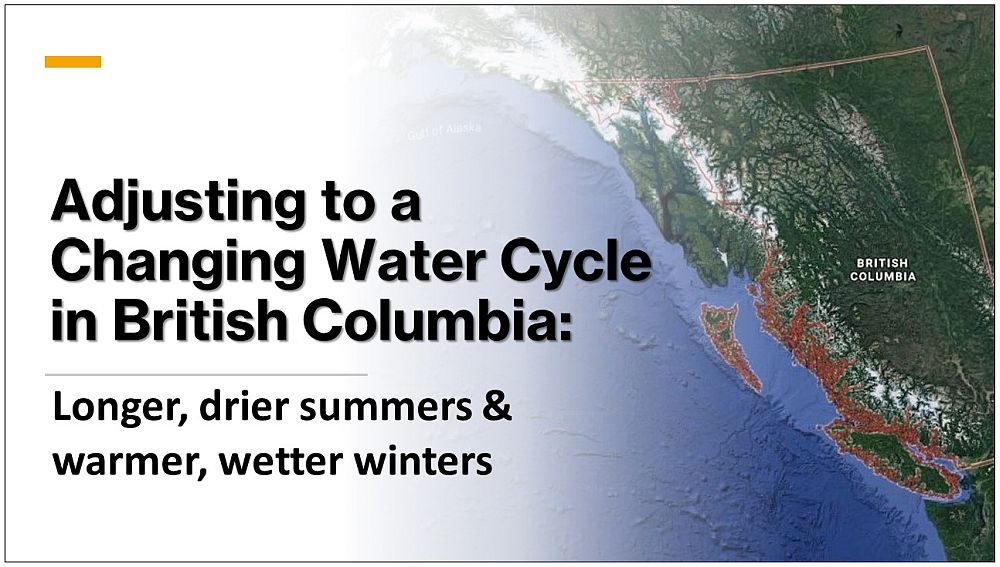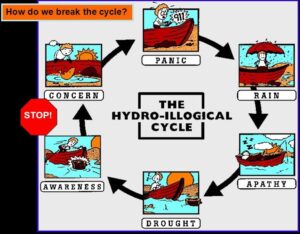FIRE & FLOOD – FACING TWO EXTREMES IN BRITISH COLUMBIA (Part 2):”Local governments, responsible for much of the mitigation work after the province reduced its role in 2003, face huge costs they cannot pay, putting people, homes, businesses and infrastructure at increasing risk,” wrote Gordon Hoekstra and Glenda Luymes (May 2022)
NOTE TO READER:
In the 7-part series published by Postmedia, and title, Fire & Flood: Facing Two Extremes, reporters Gordon Hoekstra and Glenda Luymes reveal that B.C. has fallen dangerously short of what’s required to protect our cities and towns from extreme weather events like we saw in 2021.And we fall further behind every year.

Not keeping up is catching up with B.C.
Part 2 is titled Not keeping up is catching up with B.C. Part 2 reveals that the risk of catastrophic floods continues to rise as prevention efforts lag. It shows how provincial efforts have fallen far short of what is needed to properly prepare for and reduce risks from an expected increase in the frequency and intensity of floods and wildfires in the face of climate change.
“Since the NDP took office in 2017, the province has provided $123 million for 342 flood risk reduction projects, including floodplain mapping, risk assessments, mitigation plans and actual mitigation work through a variety of programs, including federal-provincial cost-sharing partnerships. But with more than $7.74 billion needed to protect B.C. communities, it’s a drop in the bucket,” wrote Gordon Hoekstra and Glenda Luymes.
TO LEARN MORE:
To read the complete story in Part 2 of the series, download a PDF copy of Not keeping up is catching up with B.C.

Adjusting to a Changing Water Cycle in British Columbia: Longer, drier summers & warmer, wetter winters
On the weekend of November 13-14, 2021 the southwest corner of British Columbia was pounded by an epic atmospheric river. Landslides and rampaging rivers severed all highway connections between the Lower Mainland and the Interior of the province.
Barely 48 hours later (on November 17, 2021), the Partnership for Water Sustainability’s Kim Stephens delivered the keynote address at an operator educational event organized by the BC Water & Waste Association (BCWWA). Held in New Westminster, the BCWWA event was distinguished by the fact that it was not a Zoom webinar.
On the contrary, it was the first in-person event for water education in the age of COVID. Thus, it was an ironic twist that Mother Nature prevented speakers and attendees from the Interior from attending. The rippling impact of the natural disaster was further accentuated when some 20 municipal staff from the cities of Abbotsford and Chilliwack were called to duty. It was all hands on deck in those communities after widespread flooding in Sumas Prairie shutdown the Trans Canada Highway.
In summary, the historic storm and flooding was top of mind for all when Kim Stephens, Partnership Executive Director, stepped on stage to provide his career perspective on current events, and put the situation in context.
To Learn More:
Download a copy of the keynote presentation titled Adjusting to Longer and Drier Summers in British Columbia: Drought Affects Us All.

A Career Perspective on Droughts and Floods in British Columbia
“Dating back to the Halloween 1981 Flood, my engineering career has been defined by an alternating cycle of floods and droughts. This four decade history provides me with perspective that in turn allows me to put current events in context,” stated Kim Stephens.
 “In water resource engineering, we often talk about the Hydro-illogical Cycle. That means – once a decade you have a flood; once a decade you have a drought. You write a report. You put it on the shelf. A decade later, you have a flood, you have a drought, you update the reports. And so the cycle continues. As the hist0ric storm of November 2021 shows, however, no longer can we postpone action that recognizes the nature and reality of a changing water cycle.”
“In water resource engineering, we often talk about the Hydro-illogical Cycle. That means – once a decade you have a flood; once a decade you have a drought. You write a report. You put it on the shelf. A decade later, you have a flood, you have a drought, you update the reports. And so the cycle continues. As the hist0ric storm of November 2021 shows, however, no longer can we postpone action that recognizes the nature and reality of a changing water cycle.”
“Droughts affect all of us, whereas floods affect some of us. That is a fundamental distinction. For this reason, drought history is a good way to tell the story of how our climate is changing. In British Columbia, the mega-drought of 1987 was our first wake-up call. It followed a relatively benign period of some four decades. In rapid succession, we had three droughts in five years. This began to change the conversation in British Columbia.”
“Starting in 2003, we have had one teachable year after another in British Columbia. The pattern has been extremes followed by extremes: droughts, forest fires, wind storms, and floods. Each time the extremes seem to be more extreme. 2015 is a defining year. With hindsight, we can clearly see that is the year when we crossed an invisible threshold into a different hydro-meteorological regime in western North America. We are now in Year Seven of this new reality. Yet only in 2021 is in finally sinking in with the population at large that something has fundamentally changed.”
“As of 2021, we can truly say that the era of weather extremes is upon. And it has happened faster than anyone had projected or expected. Think of the terms that are now part of the everyday vocabulary in weather forecasts on the evening news: heat dome, atmospheric river, cyclone bomb.”

Extremes are More Extreme
“We have always had weather extremes in British Columbia. In my experience, dry months would follow wet months. In other words, the duration of wet and dry periods was comparatively short. On an annual basis, things had a way of balancing out. Now, however, winters are warmer and wetter. And summers are longer and drier. This new reality has huge consequences for water security, sustainability, and resiliency.”
“A generation ago, for example, water supply managers could reasonably anticipate that three months of water storage would be sufficient to maintain supply during a dry summer. Today, however, a 6-month drought is a very real likelihood, and on a repeating basis. In the meantime, populations have also grown in the major centres. From a water supply perspective, think about the implications of a doubling in the need for water storage to make it through a drought.”
“When the water resource is large and water demand is small, variability is not that noticeable. But when the demand (Water OUT) is large relative to the available resource, a variation on the supply side (Water IN) magnifies the perception of impact. In many cases, BC communities have long been operating on narrow margins.”
“When you think about it, the planet Earth is a closed loop system. Mother Nature does not create new water. The state may change – rain, snow, ice, vapour – but the water cycle is the water cycle. This means that extreme duration dry periods will of course will be followed by extreme duration wet periods. And that has been the pattern since 2015, with 2021 being the most extreme year of all as we have lurched from heat dome to epic atmospheric rivers.”
To Learn More:
- Read CONTEXT AND HISTORY REALLY DO MATTER: “In the moment, extreme events can be overwhelming. But the big picture situation is by no means hopeless. My key message is to view climate change as another variable, not a driver. Understand the system context because climate adaptation is about water, whereas climate mitigation is about carbon,” stated Kim Stephens, Executive Director, Partnership for Water Sustainability in BC (Sept 2021)
- Read ADAPTING ASSET MANAGEMENT TO CLIMATE REALITIES: “Climate change impacts are risks which can be addressed by aligning asset lifecycles to performance or change thresholds which consider how levels-of-service are likely to deteriorate in response to climate changes impacts,” stated Robert Hicks, Senior Policy and Process Engineer, City of Vancouver.
- Read THE WATER CYCLE IS OUT OF BALANCE: “While climate change is causing bigger and bigger storms, our alterations to the environment – especially to the ground surface – have been one of the major causes of the increased frequency of flooding events in modern times,” stated Professor Roland Ennos, University of Hull, when commenting on flood consequences in the United Kingdom (2015).
- Read WATCH THE VIDEO / Water and a Changing Climate / Drought Affects Us All: “When you think about it, the earth is a closed-loop system. New water is not being created. What changes is the seasonal distribution. Extreme droughts followed by extreme floods show just how unbalanced the seasonal water cycle is now,” stated Kim Stephens, Partnership for Water Sustainability (July 2021)
- Read ADJUSTING TO LONGER AND DRIER SUMMERS IN BRITSH COLUMBIA: “Since 2000, summer precipitation has dropped about 20 per cent. This means we need to be far more conscientious about summer water use,” stated Hans Schreier, a professor emeritus of land and water systems at the University of British Columbia (July 2021)

Learn From and Build Upon Experience
“A key message is that climate change is not a driver; rather, it is another variable. Climate change is only one factor to consider when we talk about the nature and consequences of extreme weather. The real issues are uncertainty and risk, more specifically how we deal with the first and manage the latter.”
“At the same time, we must recognize that we have so transformed the landscape that there are compounding unintended consequences. These are due to our widespread interference with natural processes. In November 2021, there were numerous factors in play and these combined to magnify the impacts of extreme weather.”
“In particular, the epic atmospheric river covered such a large area extending into the Interior that it resulted in a previously unimaginable scenario – a major storm coincident with high water levels in the Fraser River late in the year. In the lower Fraser Valley, this meant that inland drainage could not outflow by gravity through the dyke system and into the Fraser River. Normally the Fraser peaks in the late spring and early summer months due to snowmelt, not rainfall.”
“Another key message is that everything is connected. This requires an understanding of how the system works as a whole, rather than focusing on components in isolation of the whole. Thus, a constant challenge for planning is not to prevent past events, but instead is to use past experiences and apply systems thinking to inform and create flexible strategies for the present and the future,” concluded Kim Stephens.
To Learn More:


